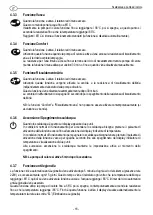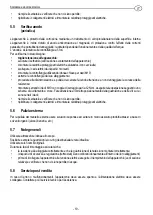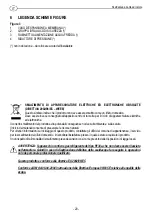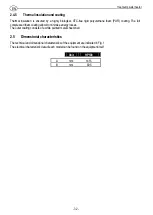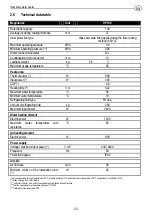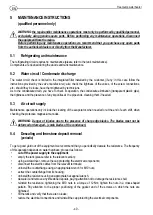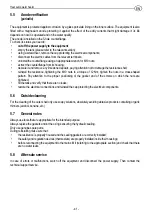
Heat pump water heater
- 30 -
EN
2
TECHNICAL AND DIMENSIONAL SPECIFICATIONS
2.1
Operating principle
The air-water heat pump uses the energy of the air existing in the environment where the pump is installed. The air
required for the proper operation of the heat pump can be drawn from the outside through a window (minimum
temperature 8°C) or from the surrounding environment. The air drawn from the environment is sucked through a fan
and the heat existing in air is absorbed during the passage in a heat exchanger (evaporator). In the evaporator the
heat taken from the air is caused to evaporate at low pressure by the coolant (the work fluid in the cooling circuit, as
in a normal fridge). The vaporised coolant is sucked by a compressor and brought to a higher level of pressure (as in
a bicycle pump) and temperature. In a second heat exchanger (condenser) the higher temperature heat is absorbed
and transferred to the water; this way the vaporised refrigerating fluid switches back to the liquid state as a
consequence of thermal dissipation. The liquid coolant, flowing through a choking component (expansion valve),
undergoes a low pressure expansion (dilatation) and, after returning to the evaporator, it can again draw heat from
the surrounding environment.
The hot water heat pump operates at ambient temperatures ranging b8°C and +32°C.
The hot water heat pump is a connection-ready equipment whose function is heating drinkable water; it basically
consists of the water tank and of the coolant, air and water circuit components, as well as of all the control,
adjustment and monitoring devices required for automatic operation.
It is also equipped with a complementary resistance, allowing to heat the output air, to increase comfort in the
environment where the water heater is installed.
> Use of the environment energy
Refrigerators, washing machines, heating systems and other equipment/electric appliances generate heat that in
most cases is not reused. Instead of being dispersed into the environment, generating pollution, the hot air in
question can suitably be used to heat sanitary water: a sensible and environment-friendly solution.
An important benefit is the air dehumidification resulting from heat suction, decreasing the degree of humidity in
cellars and laundries.
This has two beneficial effects: environment protection and production of cheap hot sanitary water.
2.2
Energy efficiency
> Free energy
The energy required for sanitary water heating is drawn for 2/3 from air and for 1/3 from the mains.
Содержание Futura 100 TS
Страница 2: ... 2 ...
Страница 22: ...Scaldacqua a pompa di calore 22 IT 8 Illustrazioni Fig 1 Fig 2 Distanze da ogni tipo di superficie ...
Страница 23: ...Scaldacqua a pompa di calore 23 IT Fig 3 Fig 4 ...
Страница 24: ...Scaldacqua a pompa di calore 24 IT ...
Страница 44: ...Heat pump water heater 44 EN 8 Illustrations Fig 1 Fig 2 Distances from any surface ...
Страница 45: ...Heat pump water heater 45 EN Fig 3 Fig 4 ...
Страница 46: ... 46 APPUNTI NOTES ...
Страница 47: ... 47 ...

